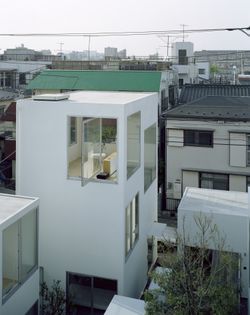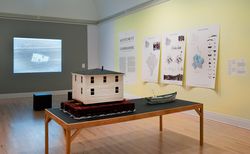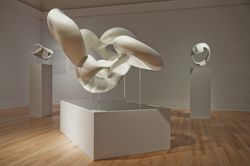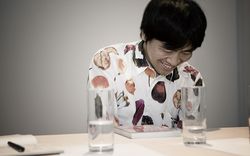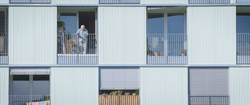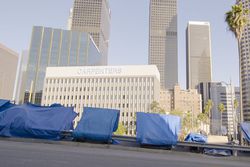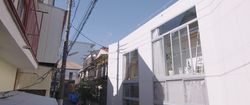Japanese architect Ryue Nishizawa speaks about his work and the CCA exhibition Some Ideas on Living in London and Tokyo by Stephen Taylor and Ryue Nishizawa (2008). The exhibition marks the first North American presentation of residential projects by Stephen Taylor and Ryue Nishizawa and reveals their distinctive solutions to the challenges of building homes in existing(...)
Paul Desmarais Theatre
14 May 2008
Ryue Nishizawa: Some Ideas on Living
Actions:
Description:
Japanese architect Ryue Nishizawa speaks about his work and the CCA exhibition Some Ideas on Living in London and Tokyo by Stephen Taylor and Ryue Nishizawa (2008). The exhibition marks the first North American presentation of residential projects by Stephen Taylor and Ryue Nishizawa and reveals their distinctive solutions to the challenges of building homes in existing(...)
Paul Desmarais Theatre
Although immigration is a dominant topic in contemporary culture, its discussion is often limited to the human experience, such as the crossing of borders and issues about national identity. Journeys takes a different perspective: how movements impact the environment. Examples range from the coconut that can drift freely on the ocean current and re-seed wherever it finds(...)
Main galleries
20 October 2010 to 13 March 2011
Journeys: How travelling fruit, ideas and buildings rearrange our environment
Actions:
Description:
Although immigration is a dominant topic in contemporary culture, its discussion is often limited to the human experience, such as the crossing of borders and issues about national identity. Journeys takes a different perspective: how movements impact the environment. Examples range from the coconut that can drift freely on the ocean current and re-seed wherever it finds(...)
Main galleries
Other Space Odysseys presents three approaches to the idea of an adventurous journey that started forty years ago after the 1969 moon landing. Featuring the work of architects Greg Lynn, Michael Maltzan, and Alessandro Poli, Other Space Odysseys comes at a time when space exploration is the subject of renewed enthusiasm, but also of debate which questions its(...)
Main galleries
8 April 2010 to 19 September 2010
Other Space Odysseys: Greg Lynn, Michael Maltzan, Alessandro Poli
Actions:
Description:
Other Space Odysseys presents three approaches to the idea of an adventurous journey that started forty years ago after the 1969 moon landing. Featuring the work of architects Greg Lynn, Michael Maltzan, and Alessandro Poli, Other Space Odysseys comes at a time when space exploration is the subject of renewed enthusiasm, but also of debate which questions its(...)
Main galleries
events
Learning from… China
In Urbanising Southern China: Poverty, Minorities, and Development, Gregory Guldin examines the social and environmental consequences of accelerated industrialisation in China, as agricultural villages become dense urban agglomerations at unprecedented rates. A specialist in Chinese urbanisation, ethnicity, and politics, Gregory Guldin is Professor of Anthropology at the(...)
3 May 2007
Learning from… China
Actions:
Description:
In Urbanising Southern China: Poverty, Minorities, and Development, Gregory Guldin examines the social and environmental consequences of accelerated industrialisation in China, as agricultural villages become dense urban agglomerations at unprecedented rates. A specialist in Chinese urbanisation, ethnicity, and politics, Gregory Guldin is Professor of Anthropology at the(...)
events
3 May 2007
articles
Ideas of living
Where We Grow Older
The documentary Where We Grow Older (CCA, 2023, 30 min) looks at how the growing ageing population is reshaping architectural and social constructs and questions the role of urban design and politics in facing these challenges. The film investigates two models of how care and housing can be reconceived in light of prolonged lives: public housing and the creation of a new(...)
Where We Grow Older
Actions:
Description:
The documentary Where We Grow Older (CCA, 2023, 30 min) looks at how the growing ageing population is reshaping architectural and social constructs and questions the role of urban design and politics in facing these challenges. The film investigates two models of how care and housing can be reconceived in light of prolonged lives: public housing and the creation of a new(...)
What It Takes to Make a Home
The CCA film What It Takes to Make a Home (2019) follows a conversation between architects Michael Maltzan (Los Angeles) and Alexander Hagner (Vienna), who address the question of homelessness through various projects.
October 2019
What It Takes to Make a Home
Actions:
Description:
The CCA film What It Takes to Make a Home (2019) follows a conversation between architects Michael Maltzan (Los Angeles) and Alexander Hagner (Vienna), who address the question of homelessness through various projects.
Project
AP148.S1.1970.PR02
Description:
The project series documents Poli's work on the Interplanetary Architecture project, which was also made into a film by Superstudio directed by Alessandro Poli (the film is not included in the fonds). The project reflects Poli's deep fascination with the moon landing in 1969. Poli uses this major media event as a catalyst for thinking about a new approach to architecture and tools for design, including the idea that film and the movie camera should become part of the toolset. The project also seems to be in some way a response to Epoch magazine's challenge for a "Primo concorso di architettura nello spazio" (the first architectural competition in space), and includes much imagery and textual references to a new road or architectural links between the earth and other planets, including an earth moon highway. In his storyboard, Poli also makes reference to his earlier Piper project, and some imagery features wheels and an amusement park. The Interplanetary Architecture project was exhibited by Superstudio in Rome in 1972 and featured in "Casabella" magazine in April 1972 (no. 364). The project was also featured in the 2010 CCA exhibition "Other Space Odysseys". In the accompanying CCA publication, Poli describes this project as "a voyage off earthbound routes in quest of architecture unfettered by the urban nightmare, by induced needs or by planning as the only tool for regulating and solving the world's problems" (Poli quoted in Borasi and Zardini, 2010, 110). Poli's work on this project is deeply tied to the Zeno project, which was also featured in this exhibition and is included in this fonds (see AP148.S1.1972.PR01). For the Zeno project, Poli envisioned a dialogue between astronaut Buzz Aldrin and an Italian peasant, Zeno of Riparbella. Poli felt that these two shared a similarity in that both their homes were isolated capsules, one that provided a lens from which to see the rest of the world and understand their place in it. The material in the series includes numerous photomontages and collages of astronauts in space, as well as drawings of plantery shapes and structures. There are also texts, some of which include calculations of distances and diameters of planets, as well as notebooks and sketchbooks, many of which Poli included in a folder he entitled "Storyboard." The series also includes an unsent letter from Poli to Adolfo Natalini which describes how, after the moon landing, everything - the planet, the moon, the stars - is architecture, and that this will necessitate the need for new design tools, such as the movie camera. Some works are signed Alessandro Poli-Superstudio. Source cited: Giovanna Borasi and Mirko Zardini, eds., Other Space Odysseys, Montreal and Baden: Canadian Centre for Architecture/Lars Müller Publishers, 2010.
1969-1971
Architettura Interplanetaria [Interplanetary Architecture] (1970-1971)
Actions:
AP148.S1.1970.PR02
Description:
The project series documents Poli's work on the Interplanetary Architecture project, which was also made into a film by Superstudio directed by Alessandro Poli (the film is not included in the fonds). The project reflects Poli's deep fascination with the moon landing in 1969. Poli uses this major media event as a catalyst for thinking about a new approach to architecture and tools for design, including the idea that film and the movie camera should become part of the toolset. The project also seems to be in some way a response to Epoch magazine's challenge for a "Primo concorso di architettura nello spazio" (the first architectural competition in space), and includes much imagery and textual references to a new road or architectural links between the earth and other planets, including an earth moon highway. In his storyboard, Poli also makes reference to his earlier Piper project, and some imagery features wheels and an amusement park. The Interplanetary Architecture project was exhibited by Superstudio in Rome in 1972 and featured in "Casabella" magazine in April 1972 (no. 364). The project was also featured in the 2010 CCA exhibition "Other Space Odysseys". In the accompanying CCA publication, Poli describes this project as "a voyage off earthbound routes in quest of architecture unfettered by the urban nightmare, by induced needs or by planning as the only tool for regulating and solving the world's problems" (Poli quoted in Borasi and Zardini, 2010, 110). Poli's work on this project is deeply tied to the Zeno project, which was also featured in this exhibition and is included in this fonds (see AP148.S1.1972.PR01). For the Zeno project, Poli envisioned a dialogue between astronaut Buzz Aldrin and an Italian peasant, Zeno of Riparbella. Poli felt that these two shared a similarity in that both their homes were isolated capsules, one that provided a lens from which to see the rest of the world and understand their place in it. The material in the series includes numerous photomontages and collages of astronauts in space, as well as drawings of plantery shapes and structures. There are also texts, some of which include calculations of distances and diameters of planets, as well as notebooks and sketchbooks, many of which Poli included in a folder he entitled "Storyboard." The series also includes an unsent letter from Poli to Adolfo Natalini which describes how, after the moon landing, everything - the planet, the moon, the stars - is architecture, and that this will necessitate the need for new design tools, such as the movie camera. Some works are signed Alessandro Poli-Superstudio. Source cited: Giovanna Borasi and Mirko Zardini, eds., Other Space Odysseys, Montreal and Baden: Canadian Centre for Architecture/Lars Müller Publishers, 2010.
Project
1969-1971
articles
5 May 2025
The Transformative Power of Film
Andrea Lissoni and Akram Zaatari on films, institutions, and their metamorphic characters
Actions:
